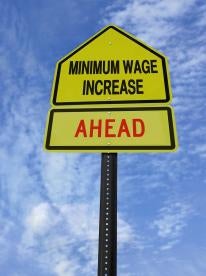The minimum wage requirements in different states, cities and counties across the country became even more of a patchwork on New Year’s day, with fourteen states adopting increased minimum wages above the federal standard of $7.25 per hour. Such states include California, Massachusetts, Michigan and Nebraska. More than a dozen cities and counties also increased their minimum wages at the end of 2015 or will do so in the Summer of 2016. Employers should pay close attention to minimum wage increases at the state and local level, because they can impact more than just employees earning the current minimum wage.
In fact, a number of states define overtime-pay exemptions for white collar workers by reference to the minimum wage, as part of the “salary test.” For example, California requires most exempt employees to earn a salary that is at least double the state minimum wage (California’s increase comes as part of a number of new or revised labor and employment laws in that state, discussed further in this post.)
For 2016, Alaska, Arkansas, California, Connecticut, Hawaii, Massachusetts, Michigan, Nebraska, New York, Rhode Island, Vermont, and West Virginia all increased their minimum wage rates, while Colorado and South Dakota had automatic annual adjustments tied to cost-of-living increases. Cities have been just as active, with significant increases taking effect in Portland (Maine), Seattle and Palo Alto as of January 1, and in Chicago, Washington, D.C. and Los Angeles this coming July, to name just a few. Indeed, over recent years, labor organizations, activists and legislators have renewed efforts to increase the federal minimum wage, as well as supporting such state and local increases.
Major Increases
The biggest upticks in the minimum wage occurred in California, Massachusetts, Alaska, Nebraska, Hawaii and West Virginia, among the states, and in Portland, Maine, Palo Alto, Los Angeles, and Washington, D.C., among cities. California and Massachusetts both increased their minimum wages from $9.00 to $10.00 per hour, while Nebraska and Alaska imposed $1.00 increases, to $9.00 and $9.75, respectively. Hawaii and West Virginia provided workers a $0.75 increase, resulting in new minimum wage rates of $8.50 and $8.75. New York has announced that it will phase in a $15.00 minimum wage for state university workers beginning in 2016 and extending over several years, a move expected to affect 28,000 employees.
Still, the real price shocks to labor costs are happening at the local level this year. Major metropolitan areas will see minimum wages above $10.00 in July of 2016, with Chicago reaching $10.50, Washington, D.C. hitting $11.50, and Los Angeles applying a $10.50 rate to employers with more than 25 employees. On January 1, Seattle continued its push to have the highest city-level minimum wage in the country, and set minimum wages of between $10.50 and $13.00 based on employer size and benefits programs. Smaller cities are increasingly setting their own minimum wages, with new rates at or above $8.50 per hour taking effect in locales as diverse as Portland, Maine, Palo Alto and Oakland, California, and Birmingham, Alabama.
Moderate and Minor Increases
2016 also features a number of more modest increases to state minimum wage rates. Michigan continued a scheduled series of increases, with an annual adjustment from $8.15 to $8.50, and increases on a similar scale were implemented for private sector workers in New York, Vermont, Rhode Island, Maryland, and Connecticut. Two states, Colorado and South Dakota, implemented minor increases of less than $0.10 each as part of an automatic cost-of-living adjustment.
As the minimum wage landscape becomes increasingly cluttered with different rates, employers should consider the compliance problems this minimum wage patchwork presents. Multi-state employers, particularly those with employees and operations in large cities, must assess not only how different components of their workforce are subject to different wage rates, but also how shifting wage rates impact overtime eligibility. In California, for example, the new minimum wage rate will have the effect of raising the overtime eligibility cutoff from $37,440 to $41,600 in annual compensation this year—thereby making virtually every white collar employee who earns less than that amount eligible for overtime, irrespective of whether the same employee is eligible for overtime under federal law. Employers who rely on federal exemptions from minimum wage and overtime laws face much greater risk under state and local laws. Vigilance is key. Employers must continuously monitor changes to wage laws in every state and local municipality in which they operate.


 i
i


